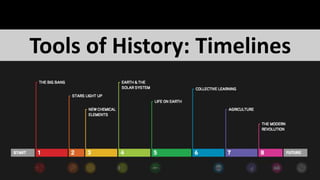
Timelines
- 1. Tools of History: Timelines
- 2. What is a timeline? • A timeline is a graphical representation of an event or process by displaying items sequentially along a line. • They can have a scale (or not). • They can be vertical, horizontal, spirals, trees... • They can include other information, text and/or pictures. • They can be valuable tools for understanding, summarising or analysing.
- 3. Timelines come in all sorts…
- 8. Ages & Periods • For convenience, historians often divide the past into ages or periods of time based on shared features, such as: • Technology, especially metalworking, e.g. Copper Age, Iron Age • Art, especially pottery • Religion, e.g. BC & AD • Rulers or family of rulers, e.g. Victorian Age, Stuart Period • Politics and ideology • It is important to remember that these ages often apply differently in different parts of the world. • Eg. “The Iron Age” - The Hittites (who lived in modern Turkey) used the first iron in the 14th century BCE. The Iron Age began in the 8th century BCE in central Europe and the 6th century BCE in northern Europe.
- 10. What eras do you know? Activity 1: Think, pair, share • Think about ages or periods in history you already know. Make a list in your workbook. • Share your ideas with those around you – add any periods you don’t have to your list. • Be ready to share your ideas with the class. Activity 2: Worksheet Timeline • Write down at least 3 Ages/Periods from the period BC and 3 Ages/Periods from the period AD from the board. • Use the boxes to illustrate an event or what you think life was like at one moment. Connect your boxes with lines to the date they illustrate on the timeline. Activity 3: Prep Task 5 - Draw a timeline of your life – from the birth of your grandparents to now. • Include: -5 family events -5 world events - at least 5 other events of your choice • Make sure your timeline has a scale showing the decades (i.e. mark and label every 10 years) • Pen and paper is fine but you might like to try using an online app to draw your timeline. • Upload your completed timeline to the forum on CGS Connect.
